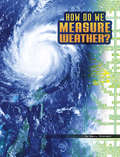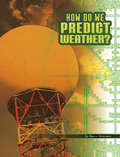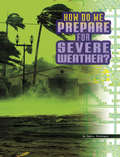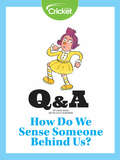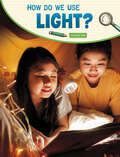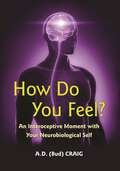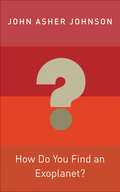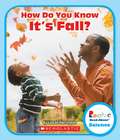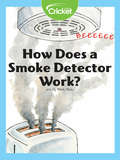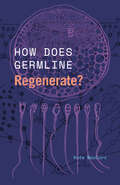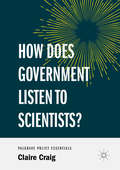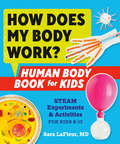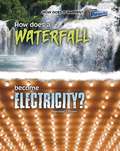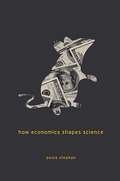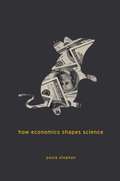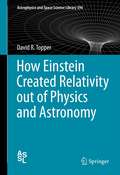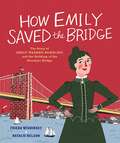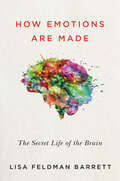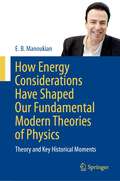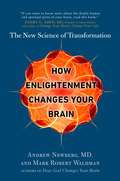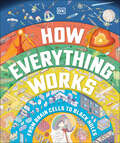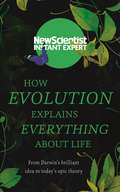- Table View
- List View
How Do We Measure Weather? (Discover Meteorology)
by Nancy DickmannHow fast is the wind blowing? How much moisture is in the air? Meteorologists measure weather conditions to help answer these and other questions. Learn about the tools and systems they use. Find out how these measurements help people plan their days and prepare for any weather.
How Do We Predict Weather? (Discover Meteorology)
by Nancy DickmannWill tomorrow be cold or warm? Cloudy or sunny? Wet or dry? Meteorologists make predictions about how weather conditions will change. Find out how they do it and what challenges they face in trying to help people prepare for coming weather conditions.
How Do We Prepare for Severe Weather? (Discover Meteorology)
by Nancy DickmannA storm is coming! How do people prepare? What supplies and tools do we need to survive? Find out how people prepare for all kinds of severe weather. From tornadoes to hurricanes and blizzards to floods, we can be ready for anything.
How Do We Sense Someone Behind Us?
by Lizzie WadeHow do humans sense when someone is behind them? This Q & A explains the science of peripheral vision.
How Do We Use Light? (Science Inquiry)
by Emily RaijLight is all around us. What is light? Where does it come from? How does it help us see? Readers investigate and read straightforward text accompanied by vibrant photos to learn all about light.
How Do Weather And Climate Affect Our Lives?: Student Activity Guide
by The Smithsonian InstitutionNIMAC-sourced textbook
How Do You Feel?: An Interoceptive Moment with Your Neurobiological Self
by A. D. CraigA book that fundamentally changes how neuroscientists and psychologists categorize sensations and understand the origins and significance of human feelingsHow Do You Feel? brings together startling evidence from neuroscience, psychology, and psychiatry to present revolutionary new insights into how our brains enable us to experience the range of sensations and mental states known as feelings. Drawing on his own cutting-edge research, neurobiologist Bud Craig has identified an area deep inside the mammalian brain—the insular cortex—as the place where interoception, or the processing of bodily stimuli, generates feelings. He shows how this crucial pathway for interoceptive awareness gives rise in humans to the feeling of being alive, vivid perceptual feelings, and a subjective image of the sentient self across time. Craig explains how feelings represent activity patterns in our brains that signify emotions, intentions, and thoughts, and how integration of these patterns is driven by the unique energy needs of the hominid brain. He describes the essential role of feelings and the insular cortex in such diverse realms as music, fluid intelligence, and bivalent emotions, and relates these ideas to the philosophy of William James and even to feelings in dogs.How Do You Feel? is also a compelling insider's account of scientific discovery, one that takes readers behind the scenes as the astonishing answer to this neurological puzzle is pursued and pieced together from seemingly unrelated fields of scientific inquiry. This book will fundamentally alter the way that neuroscientists and psychologists categorize sensations and understand the origins and significance of human feelings.
How Do You Find an Exoplanet?
by John Asher JohnsonAlien worlds have long been a staple of science fiction. But today, thanks to modern astronomical instrumentation and the achievements of many enterprising observational astronomers, the existence of planets outside our solar system--also known as exoplanets--has moved into the realm of science fact. With planet hunters finding ever smaller, more Earth-like worlds, our understanding of the cosmos is forever changed, yet the question of how astronomers make these discoveries often goes unanswered.How Do You Find an Exoplanet? is an authoritative primer on the four key techniques that today's planet hunters use to detect the feeble signals of planets orbiting distant stars. John Johnson provides you with an insider's perspective on this exciting cutting-edge science, showing how astronomers detect the wobble of stars caused by the gravitational tug of an orbiting planet, the slight diminution of light caused by a planet eclipsing its star, and the bending of space-time by stars and their planets, and how astronomers even directly take pictures of planets next to their bright central stars.Accessible to anyone with a basic foundation in college-level physics, How Do You Find an Exoplanet? sheds new light on the prospect of finding life outside our solar system, how surprising new observations suggest that we may not fully understand how planets form, and much more.
How Do You Know It's Fall?
by Lisa M. HerringtonThese charming science books, written for the youngest readers, will teach children how to read the cues from nature and be able to differentiate one season to the next. Simple hands-on experiments that introduce young readers to everyday science Fun activities that allow young scientists to make observations about the world around them Fast facts - offering fun, sometimes little known facts about the subject Low, accessible reading level for emergent and struggling readers Glossary with pictures provides a visual review of important vocabulary terms Additional content for further learning on this subject available at www. factsfornow. scholastic. com
How Does a Smoke Detector Work?
by Liz HuyckEver wonder why a smoke alarm goes off? A battery, siren, and metal can work together to detect smoke and sound the alarm when catching a whiff of smoke.
How Does Germline Regenerate? (Convening Science: Discovery at the Marine Biological Laboratory)
by Kate MacCordA concise primer that complicates a convenient truth in biology—the divide between germ and somatic cells—with far-reaching ethical and public policy ramifications. Scientists have long held that we have two kinds of cells—germ and soma. Make a change to germ cells—say using genome editing—and that change will appear in the cells of future generations. Somatic cells are “safe” after such tampering; modify your skin cells, and your future children’s skin cells will never know. And, while germ cells can give rise to new generations (including all of the somatic cells in a body), somatic cells can never become germ cells. How did scientists discover this relationship and distinction between somatic and germ cells—the so-called Weismann Barrier—and does it actually exist? Can somatic cells become germ cells in the way germ cells become somatic cells? That is, can germ cells regenerate from somatic cells even though conventional wisdom denies this possibility? Covering research from the late nineteenth century to the 2020s, historian and philosopher of science Kate MacCord explores how scientists came to understand and accept the dubious concept of the Weismann Barrier and what profound implications this convenient assumption has for research and policy, from genome editing to stem cell research, and much more.
How Does Government Listen to Scientists?
by Claire CraigThis Palgrave Policy Essential draws together recent developments in the field of science in government, policy and public debate. Practice and academic insights from a wide variety of fields have both moved on in the last decade and this book provides a consolidated survey of the relatively well established but highly scattered set of insights about the provision of deeply technical expertise in policy making (models of climate or disease, risk, Artificial Intelligence and ethics, and so on). It goes on to link this to emerging ideas about futures thinking, public engagement, narrative, and the role of values and sentiment alongside the place of scientific and scholarly insights in public decision-making and debate. The book offers an accessible overview aimed at practitioners; policy-makers looking to understand how to work with researchers, researchers looking to work with policy-makers, and the increasing numbers and types of “brokers” - people working at the interface, in science advice, public engagement and communication of science, and in expert support to decision-making in the public and private sectors. In addition to outlining recent insights and placing them in the established frameworks of authors such as Pielke and Jasanoff, the book also brings in relevant areas less traditionally associated with the subject but of increasing importance, such as modelling, futures and narrative.
How Does Motion Energy Change in a Collision?: Student Activity Guide
by The Smithsonian InstitutionNIMAC-sourced textbook
How Does My Body Work? Human Body Book for Kids: STEAM Experiments and Activities for Kids 8-12
by Sara LaFleurHow does your body work? This fun human anatomy book helps kids 8-12 answer that question through awesome, hands-on STEAM/STEM experiments and activities.Entertaining and interactive, The Human Body Book for Kids shows curious kids how their body systems help them move, breathe, fight infections, and keep them alive!Filled with fascinating information about human anatomy, this exciting science book features: • More than 40 STEAM experiments and activities that help kids learn about their amazing bodies. • Full-color illustrations and photographs that highlight the cells, tissues, organs and body systems as well as explain the steps and outcomes of the experiments. • A doctor author, an MD who works with both children and adults and is an expert on the human body inside and out. • Weird and wonderful facts about the human body: Did you know that you&’re about 1 cm taller in the morning than the evening? That a baby is born with 300 bones but has only 206 by the time they&’re an adult? That some children are born with an extra set of ribs surrounding the lungs called &“gorilla ribs&”? • Learning and fun together: Kids will create models, eat experiments, and show off their STEAM skills to family and friends. Endorsed by the co-founder of Apple&’s Siri, this educational book is a great resource for answering kids&’ questions about how their bodies work.
How Does Olive Oil Lose its Virginity?: Answers to the Enigmatic Questions of Contemporary Life
by Bruce Tindall Mark WatsonThis much anticipated sequel to the authors' popular Did Mohawks Wear Mohawks? stimulates the mind as much as it tickles the funny bone with scores of concise, witty answers to the questions you never dared to ask Mom or your high school science teacher! From the ridiculous to the sublime, Tindall and Watson tackle the conundrums of the day, examining everything from the history of "booing" bad performances to the mysterious darkness that lurks in the heart of the oyster. Whether the subject is soft drinks or shrunken heads, bumper stickers or boomerangs, How Does Olive Oil Lose Its Virginity? is your road map through an increasingly wacky world. With over 50 questions on a myriad of topics, How Does Olive Oil Lose Its Virginity? provides readers with hours of entertainment and a wealth of factual knowledge. Each answer has been carefully researched and well documented and offers great background information. And of course, all the answers are peppered with the trademark wit and spunk popularized by Tindall and Watson.
How Does A Waterfall Become Electricity? (How Does It Happen)
by Robert SneddenWhat is the world's tallest waterfall?What is the world's tallest waterfall? How do dams help generate water power? What happens when a waterwheel spins? This series explores the causes and effects that shape our world. From the underwater volcanoes that sprout into islands, to the rushing waterfalls that spark electric currents, this series demonstrates how both natural and man-made phenomena occur.
How Economics Shapes Science
by Paula StephanAt a time when science is seen as an engine of economic growth, Paula Stephan brings a keen understanding of the cost-benefit calculations made by individuals and institutions as they compete for resources and reputation in scientific fields. She highlights especially the growing gap between the biomedical sciences and physics/engineering.
How Economics Shapes Science
by Paula StephanThe beauty of science may be pure and eternal, but the practice of science costs money. And scientists, being human, respond to incentives and costs, in money and glory. Choosing a research topic, deciding what papers to write and where to publish them, sticking with a familiar area or going into something new—the payoff may be tenure or a job at a highly ranked university or a prestigious award or a bump in salary. The risk may be not getting any of that. At a time when science is seen as an engine of economic growth, Paula Stephan brings a keen understanding of the ongoing cost-benefit calculations made by individuals and institutions as they compete for resources and reputation. She shows how universities offload risks by increasing the percentage of non-tenure-track faculty, requiring tenured faculty to pay salaries from outside grants, and staffing labs with foreign workers on temporary visas. With funding tight, investigators pursue safe projects rather than less fundable ones with uncertain but potentially path-breaking outcomes. Career prospects in science are increasingly dismal for the young because of ever-lengthening apprenticeships, scarcity of permanent academic positions, and the difficulty of getting funded. Vivid, thorough, and bold, How Economics Shapes Science highlights the growing gap between the haves and have-nots—especially the vast imbalance between the biomedical sciences and physics/engineering—and offers a persuasive vision of a more productive, more creative research system that would lead and benefit the world.
How Einstein Created Relativity out of Physics and Astronomy
by David TopperThis book tracks the history of the theory of relativity through Einstein's life, with in-depth studies of its background as built upon by ideas from earlier scientists. The focus points of Einstein's theory of relativity include its development throughout his life; the origins of his ideas and his indebtedness to the earlier works of Galileo, Newton, Faraday, Mach and others; the application of the theory to the birth of modern cosmology; and his quest for a unified field theory. Treading a fine line between the popular and technical (but not shying away from the occasional equation), this book explains the entire range of relativity and weaves an up-to-date biography of Einstein throughout. The result is an explanation of the world of relativity, based on an extensive journey into earlier physics and a simultaneous voyage into the mind of Einstein, written for the curious and intelligent reader.
How Emily Saved the Bridge: The Story of Emily Warren Roebling and the Building of the Brooklyn Bridge
by Frieda WishinskyThe amazing story of Emily Warren Roebling, the woman who stepped in to oversee the construction of the Brooklyn Bridge, which was completed in 1883.Emily was not an engineer, but she was educated in math and science. She married Washington Roebling, the chief engineer of the famous bridge. When Washington became ill from decompression sickness, Emily stepped in, doing everything from keeping the books, to carrying messages for her husband, to monitoring the construction of the bridge. She was the first person to cross the Brooklyn Bridge when it opened.Emily, who went on to study law among many other accomplishments, is an inspiration to all, as demonstrated through Frieda Wishinsky’s informative and engaging text and Natalie Nelson’s distinctive collage illustrations. Speech bubbles revealing imagined dialogue add a playful note to this historical account, which includes fascinating facts about the Brooklyn Bridge and a further reading list.Key Text Featuresfurther readingspeech bubblesCorrelates to the Common Core State Standards in English Language Arts:CCSS.ELA-LITERACY.RL.2.1Ask and answer such questions as who, what, where, when, why, and how to demonstrate understanding of key details in a text.CCSS.ELA-LITERACY.RL.4.3Describe in depth a character, setting, or event in a story or drama, drawing on specific details in the text (e.g., a character's thoughts, words, or actions).
How Emotions Are Made: The Secret Life of the Brain (Expert Thinking Ser.)
by Prof. Lisa Feldman BarrettA new theory of how the brain constructs emotions that could revolutionize psychology, health care, law enforcement, and our understanding of the human mind Emotions feel automatic, like uncontrollable reactions to things we think and experience. Scientists have long supported this assumption by claiming that emotions are hardwired in the body or the brain. Today, however, the science of emotion is in the midst of a revolution on par with the discovery of relativity in physics and natural selection in biology—ans this paradigm shift has far-reaching implications for us all. Leading the charge is psychologist and neuroscientist Lisa Feldman Barrett, whose theory of emotion is driving a deeper understanding of the mind and brain, and shedding new light on what it means to be human. Her research overturns the widely held belief that emotions are housed in different parts of the brain and are universally expressed and recognized. Instead, she has shown that emotion is constructed in the moment, by core systems that interact across the whole brain, aided by a lifetime of learning. This new theory means that you play a much greater role in your emotional life than you ever thought. Its repercussions are already shaking the foundations not only of psychology but also of medicine, the legal system, child-rearing, meditation, and even airport security. Why do emotions feel automatic? Does rational thought really control emotion? How does emotion affect disease? How can you make your children more emotionally intelligent? How Emotions Are Made answers these questions and many more, revealing the latest research and intriguing practical applications of the new science of emotion, mind, and brain.
How Energy Considerations Have Shaped Our Fundamental Modern Theories of Physics: Theory and Key Historical Moments
by E. B. ManoukianAt long last, with sufficient technical details, emphasizing key historical moments, a book that develops all of fundamental modern theoretical physics from energy considerations in a compact form. Starting with a few electron-volts of atoms in the quantum world at low energies extending up to quantum gravity and beyond to the birth of the Universe, readers will experience the entire spectrum of fundamental modern theoretical physics, with one theory leading to another in an integrated unified manner. Energy considerations lead to the development of special and general relativity, quantum field theory, renormalization theory, modern quantum electrodynamics, electro-weak theory, the standard model of particle physics, grand unified theories, string theory, the current standard model of inflationary big bang theory, and even to the birth of the Higgs field, and in developments of quantum gravity. Unfortunately, due to strong specialization within theirfields, students and many practicing physicists are exposed only to parts of the beautiful story of modern fundamental physics. Here the entire story is told! This is a must-read book for graduate students, advanced undergraduate students, instructors and professionals who are interested in all aspects of fundamental modern theoretical physics and key historical moments in its development.
How Enlightenment Changes Your Brain: The New Science of Transformation
by Andrew Newberg Mark Robert WaldmanThe bestselling authors of How God Changes Your Brain reveal the neurological underpinnings of enlightenment, offering unique strategies to help readers experience its many benefits. In this original and groundbreaking book, Andrew Newberg, M.D., and Mark Robert Waldman turn their attention to the pinnacle of the human experience: enlightenment. Through his brain- scan studies on Brazilian psychic mediums, Sufi mystics, Buddhist meditators, Franciscan nuns, Pentecostals, and participants in secular spirituality rituals, Newberg has discovered the specific neurological mechanisms associated with the enlightenment experience--and how we might activate those circuits in our own brains. In his survey of more than one thousand people who have experienced enlightenment, Newberg has also discovered that in the aftermath they have had profound, positive life changes. Enlightenment offers us the possibility to become permanently less stress-prone, to break bad habits, to improve our collaboration and creativity skills, and to lead happier, more satisfying lives. Relaying the story of his own transformational experience as well as including the stories of others who try to describe an event that is truly indescribable, Newberg brings us a new paradigm for deep and lasting change.From the Hardcover edition.
How Everything Works
by DKDiscover an all-in-one encyclopedia that takes you on an explanatory tour of the world from your own body to outer space.Have you ever wondered how an email gets to someone on the other side of the world in just a few seconds or why it&’s a bad idea to stand under a tree during a thunderstorm? Discover the answers to all these questions and more with these mind-boggling how things work books for children aged 9 and above!Each page of this mind-blowingly detailed and ambitious encyclopedia will guide you through the natural world and the technology that surrounds you. Giant, page-filling illustrations take objects apart – or take the roofs and walls off buildings – to show you how they work, explaining both basic principles (such as photosynthesis) as well as broader concepts (like how all the living things in a rainforest interact). Explore each and every page of this engaging how things work book to discover:- Key insights into both the natural and human worlds- Striking photography that brings certain concepts to life- A diverse range of chapters coinciding with STEM subjects at school In this how things work encyclopedia, chapters range from the human body to cities and industry, to planet Earth, taking in sleep patterns, cooking, sewage systems, wind farms, fungi spores, and plate tectonics along the way. How Everything Works is perfect for children studying STEM subjects at school or anyone who is simply curious about how nature and the modern world work.
How Evolution Explains Everything About Life: From Darwins brilliant idea to todays epic theory (Instant Expert Ser.)
by New ScientistHow did we get here? All cultures have a creation story, but a little over 150 years ago Charles Darwin introduced a revolutionary new one. We, and all living things, exist because of the action of evolution on the first simple life form and its descendants.We now know that it has taken 3.8 billions of years of work by the forces of evolution to turn what was once a lump of barren rock into the rich diversity of into plants, animals and microbes that surround us. In the process, evolution has created all manner of useful adaptions, from biological computers (brains) to a system to capture energy from the sun (photosynthesis). But how does evolution actually work? In Evolution, leading biologists and New Scientist take you on a journey of a lifetime, exploring the question of whether life is inevitable or a one-off fluke, and how it got kick-started. Does evolution have a purpose or direction? Are selfish genes really the driving force of evolution? And is evolution itself evolving?ABOUT THE SERIESNew Scientist Instant Expert books are definitive and accessible entry points to the most important subjects in science; subjects that challenge, attract debate, invite controversy and engage the most enquiring minds. Designed for curious readers who want to know how things work and why, the Instant Expert series explores the topics that really matter and their impact on individuals, society, and the planet, translating the scientific complexities around us into language that's open to everyone, and putting new ideas and discoveries into perspective and context.
